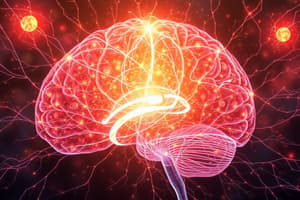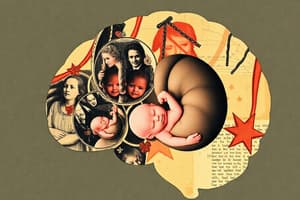Podcast
Questions and Answers
What is the primary function of the prefrontal cortex?
What is the primary function of the prefrontal cortex?
- Semantic memory
- Spatial reasoning
- Attention
- Decision-making (correct)
When does myelin formation mostly conclude in development?
When does myelin formation mostly conclude in development?
- In late adolescence
- At birth
- In young adulthood (correct)
- During early childhood
Which brain region is involved in spatial reasoning?
Which brain region is involved in spatial reasoning?
- Posterior parietal cortex (correct)
- Cerebellum
- Prefrontal cortex
- Anterior temporal cortex
Why are early experiences critical during sensitive periods of brain development?
Why are early experiences critical during sensitive periods of brain development?
How does the pattern of brain development proceed?
How does the pattern of brain development proceed?
What is the role of primary relationships in brain development during sensitive periods?
What is the role of primary relationships in brain development during sensitive periods?
Which factor contributes to neuroplasticity in the brain?
Which factor contributes to neuroplasticity in the brain?
What is the significance of the Circle of Willis in the brain?
What is the significance of the Circle of Willis in the brain?
Which outcome can result from early impoverishment of experiences during sensitive periods?
Which outcome can result from early impoverishment of experiences during sensitive periods?
Which of the following describes how the brain is affected during periods of neuroplasticity?
Which of the following describes how the brain is affected during periods of neuroplasticity?
What drives the sequence of events during in utero brain development?
What drives the sequence of events during in utero brain development?
At what week do neurons begin to form during neurogenesis?
At what week do neurons begin to form during neurogenesis?
Which statement is true about the process of cell maturation?
Which statement is true about the process of cell maturation?
During synapse formation, when does the process begin?
During synapse formation, when does the process begin?
What happens during synaptic pruning?
What happens during synaptic pruning?
What primarily influences the connections formed in the brain during development?
What primarily influences the connections formed in the brain during development?
What characterizes dendritic and axonal growth during maturation?
What characterizes dendritic and axonal growth during maturation?
What is the 'prime time' for synapse formation after birth?
What is the 'prime time' for synapse formation after birth?
Flashcards
Myelin Formation
Myelin Formation
The process of creating myelin, a fatty substance that insulates nerve fibers, improving signal transmission in the brain. It begins before birth and largely completes in early adulthood.
Prefrontal Cortex
Prefrontal Cortex
The part of the brain responsible for higher-level cognitive functions like planning, decision-making, and social behavior. It undergoes significant pruning in late adolescence.
Posterior Parietal cortex
Posterior Parietal cortex
The brain region involved in spatial awareness, attention, and planning movements. Myelination of this area continues into young adulthood.
Anterior Temporal Cortex
Anterior Temporal Cortex
Signup and view all the flashcards
Sensitive Periods
Sensitive Periods
Signup and view all the flashcards
Neuroplasticity
Neuroplasticity
Signup and view all the flashcards
Circle of Willis
Circle of Willis
Signup and view all the flashcards
Adding & Pruning of Neural Circuits
Adding & Pruning of Neural Circuits
Signup and view all the flashcards
Serve & Return Interactions
Serve & Return Interactions
Signup and view all the flashcards
Neurogenesis
Neurogenesis
Signup and view all the flashcards
Cell Migration
Cell Migration
Signup and view all the flashcards
Cell Differentiation
Cell Differentiation
Signup and view all the flashcards
Cell Maturation
Cell Maturation
Signup and view all the flashcards
Synapse Formation
Synapse Formation
Signup and view all the flashcards
Synaptic Pruning
Synaptic Pruning
Signup and view all the flashcards
Critical Period
Critical Period
Signup and view all the flashcards
Study Notes
Course Information
- Course name: Neurology Foundations 2
- Course code: OCCTH 583
- Instructor: Jennifer Krysa, MSc
- Credentials: Registered Occupational Therapist (AB)
- University: University of Alberta
Outline
- Brain Development
- A Spider's Tale
- Neuro Games
Brain Development
- Two phases of neurocircuitry development:
- In utero: genetically determined events influenced by the maternal environment.
- Prenatal and postnatal: emerging connections respond to environment and experiences.
- Specific stages of brain development:
- Neurogenesis
- Cell Migration
- Cell Differentiation
- Cell Maturation
- Synaptic Formation
- Synaptic Pruning
- Myelin Formation
Neurogenesis
- Genesis: the origin or formation of something.
- Neurogenesis: the formation of neurons.
- In utero timeline:
- Week 3: neurons begin to form, creating the neural tube.
- Week 6: cells that become the cerebrum begin to divide.
- 14 weeks: cerebrum is largely formed.
- 7 months: sulci and gyri (folds) appear.
- Continued neuron formation occurs in the hippocampus throughout middle age.
- Activities like new learning and exercise can stimulate ongoing neuron generation.
Cell Migration and Differentiation
- Newly formed neurons travel along glial cells to the outer surface of the cerebral cortex.
- The cerebral cortex develops in six layers, sequentially from the inside out.
- Neurons migrate to specific regions of the cortex.
- Neurons differentiate into various cell types, forming axons and dendrites.
- Synapses are created, and neurotransmitters (NTs) are synthesized.
Cell Maturation
- Cells mature at their final location.
- Dendrite formation begins in utero and continues postnatally.
- Dendritic growth is slower than axon growth (approximately 1000 times slower).
- The abundance of axons influences the differentiation of dendrites.
- Initially, more axons and dendrites are produced than are ultimately needed.
Synapse Formation
- Synapse formation starts around week 23 of prenatal development and continues postnatally.
- The prime time for synapse formation is the first two years after birth.
- Up to 700 synapses are formed per second (due to overproduction).
- Basic brain processes develop first, followed by more complex functions.
- Most neural connections develop and locate on the cortex in response to experiences and the environment.
Synaptic Pruning
- Unused neurons and neural circuits are pruned away.
- The most used synapses remain, highlighting the importance of experience and environment in brain development.
- The timing of pruning is variable.
- The visual cortex prunes in early childhood, typically until approximately age six.
- The prefrontal cortex prunes in late adolescence.
Myelin Formation
- Glial cells develop, enabling myelin formation.
- Myelin formation begins prenatally and largely finishes in young adulthood.
- Myelin formation occurs in waves.
- Specific areas of the brain myelinate after age 18:
- Prefrontal cortex
- Posterior parietal cortex
- Anterior temporal cortex
Prefrontal Cortex
- Associated functions:
- Decision-making
- Reasoning
- Social appropriateness
- Personality expression
- Complex cognitive behaviors
Posterior Parietal Cortex
- Associated functions:
- Spatial reasoning
- Attention
- Planned movement
Anterior Temporal Cortex
- Associated functions:
- Semantic memory
- Knowledge of facts, words, people, and objects
Pattern of Brain Development
- Brain development occurs hierarchically, starting from low-level interpretation of sensory stimuli (prenatal and at birth).
- Higher-level development, such as interpretation of facial expression and language acquisition, emerges.
- Development is heavily influenced by exposure to different environments and experiences during critical periods.
- Skills naturally develop according to this pattern.
Sensitive Periods
- Sensitive periods occur at different ages for different parts of the brain.
- Stimulating environments and experiences enhance brain architecture.
- Early stimulating experiences are crucial for building the foundation for later learning
- Lower-level circuitry must provide precise, high-quality information to the higher-level circuitry for successful complex task performance.
- Neural circuits are formed and pruned.
- Development includes vision, hearing, motor control, emotional response, social cues, and language acquisition.
- As higher-level circuitry matures needs more diverse and sophisticated experiences.
- Early deprivation can have lifelong implications.
- Primary relationships have an impact on brain architecture and development.
- Serve-and-return interactions with caregivers are vital.
Neuroplasticity
- The brain's capacity to form and reorganize synaptic connections in response to positive stimuli (e.g., learning) or negative stimuli (e.g., injury).
- Examples of stimuli promoting neuroplasticity include novelty, complexity, effortful tasks, sustained attention.
A Spider's Tale
- A fictional spider, named Willis, lives on the pons.
- Description of Willis:
- Nose, eyebrows, suckers for a mouth.
- Eyes looking outward.
- Crew cut, fuzzy beard.
- Two pairs of antennae.
- Eight legs, two pairs under the head, two pairs attached at the end of the body.
- Short feelers located at the end of the last pair of legs.
- Male.
Significance of the Circle of Willis
- Collateral blood flow between anterior and posterior circulations of the brain.
- Protection against ischemia or damage in one or more areas.
Neuro Games
- Launch point for activities and practice related to brain functions in the context of the course topic.
Studying That Suits You
Use AI to generate personalized quizzes and flashcards to suit your learning preferences.



